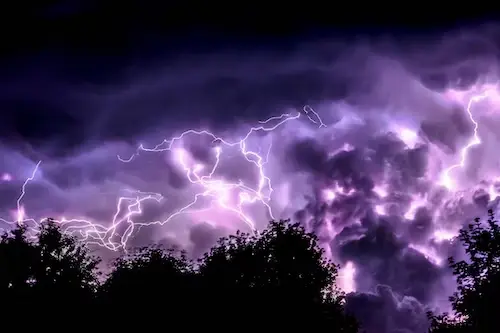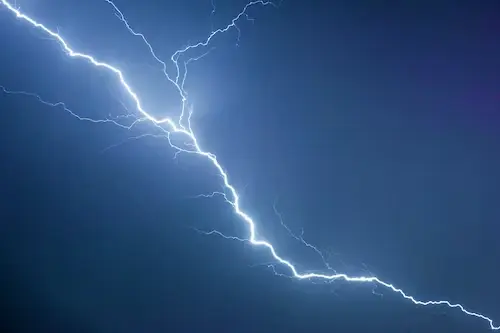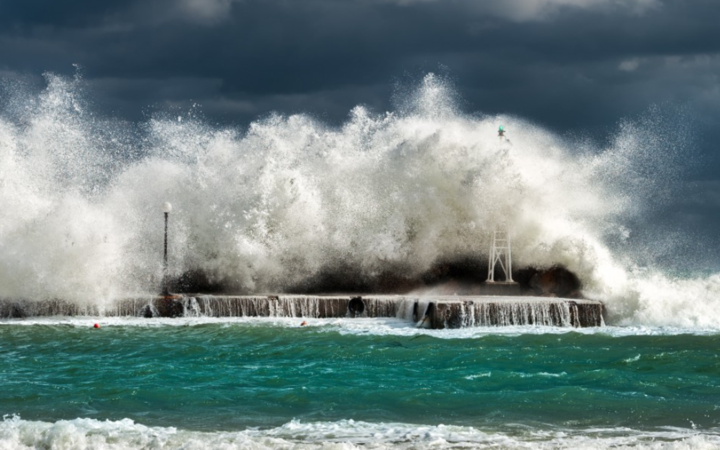At each moment, there are about 2,000 thunderstorms occurring on Earth.
Thunderstorms are a force of nature, it is one of the most severe. Even light storms produce dangerous lightning and must be respected.
Show key points
- Thunderstorms are common worldwide, with roughly 16 million occurring annually and up to 2,000 active at any given moment.
- Lightning from thunderstorms is extremely dangerous, and the safest place during a storm is indoors, away from windows and doors.
- Thunderstorms require specific conditions to form, including humidity, instability, and rising air, often drawing moisture from distant oceans.
- ADVERTISEMENT
- Each thunderstorm goes through three distinct stages—development, maturity, and dissipation—each with its own weather characteristics.
- There are four main types of thunderstorms: single-cell, multicellular, squall lines, and supercells, each varying in intensity and duration.
- Lightning strikes can be fatal or cause serious injuries, and it's crucial to seek immediate shelter when thunder is heard.
- Storm activity isn't unique to Earth—planets like Venus, Jupiter, Saturn, and Neptune also experience powerful and long-lasting storms.
No matter how strong the storm is, the best place to be during a thunderstorm is inside, away from doors and windows. Always remember to act on the adage "When thunder roars, go inside." If you can't get inside, the next safest place is a car with a hard roof, all with its windows raised. Thunder is the sound made by lightning and can be heard about 10 miles from a lightning strike. As soon as you hear the sound of thunder, you should always head inside immediately.
They are extremely common

To be sure, thunderstorms are not a daily event at the local level, but a daily event globally. Worldwide, an estimated 16 million thunderstorms occur each year. At any given moment, up to 2,000 thunderstorms could occur across the planet.
Recommend
In certain parts of the world, thunderstorms are more common than elsewhere. In the United States, Florida has the highest number of thunderstorms. Some parts of South Florida experience thunderstorms of 108 days or more annually. Meanwhile, coastal areas of California, Oregon and Washington experience only nine days or less of thunderstorms annually.
On Earth, the place that is exposed to the greatest number of lightning strikes from thunderstorms is Lake Maracaibo in Venezuela. The region experiences massive thunderstorms between 140 and 160 nights a year, and these storms can cause an average of 28 lightning strikes per minute.
They all form in the same way.

For a thunderstorm to form, certain weather conditions are needed. Besides humidity, the formation of thunderstorms requires instability and air rising, causing air to move in the atmosphere. Moisture often comes from the ocean, even in places far from the coast, thanks to strong winds. Instability can occur when warm, moist air near the ground pushes upwards into cooler, drier air. As air is pushed upwards, thunderclouds form.
A thunderstorm goes through a life cycle, as do all living things. Each storm has three phases: the stage of emergence, the stage of maturity, and the stage of dissipation. The evolutionary phase is when warm, moist air pushes upwards, causing storm clouds to form. During the evolutionary stage, little if any rain falls, but lightning and thunder can sometimes occur.
The maturation phase begins when heavy rainfall begins, causing a downward air current. The maturation stage is the most dangerous stage of a storm's life, in which a storm is capable of producing heavy rain, hail, lightning, strong winds and even hurricanes. The final stage, the dissipation phase, occurs when the downstream overcomes the upstream. During this phase, rainfall can continue, but with less intensity. Lightning can also continue to occur.
There are several different types

While all thunderstorms form in the same way, they are not equal. There are four different types of thunderstorms. The simplest storms are single-celled thunderstorms. These storms are usually small and weak, lasting only an hour or two. These are storms that we often encounter in the summer afternoons because they arise as the air warms up during the day. These storms can produce heavy rain and lightning.
Multicellular storms are another common type, often preceded by high winds. These storms can last a few hours, often produce heavy rain, and can be accompanied by strong winds, hail, flooding and short hurricanes. Storm lines are groups of storms arranged in a long line, sometimes hundreds of miles long. They are usually accompanied by high winds and heavy rain, and pass quickly because these systems of lines are usually no more than 10 miles to 20 miles wide.
Super cells are well-organized and long-lasting storms. These powerful storms are fueled by a rotating upstream, and thunderclouds can rise up to 50,000 feet above the ground. Most large hurricanes are the result of supercellular thunderstorms.
It's more dangerous than people think.

When we think about extreme weather events, tornadoes and hurricanes are likely to top the list, but thunderstorms – especially lightning – can be fatal. From 2009 to 2018, the number of lightning-related deaths in the United States was 27.
Only about 10% of people who develop lightning die, and the remaining 90% can suffer varying levels of injury and disability. The odds of lightning are about 1 in 1.22 million a year, and the odds of lightning in your lifetime are about 1 in 15,300. For comparison, keep in mind that the odds of winning the lottery jackpot are around 1 in 292.2 million.
Always remember that nowhere is safe outside when thunderstorms are nearby. If you hear thunder, the lightning is close enough to hit you. So when you hear thunder, move inward or into a secure structure, such as a closed vehicle with a metal roof. If you happen to be stuck outside, stay away from high areas and exit any body of water. Stay away from objects that can connect electricity, such as transmission lines or barbed wire fencing, and never take shelter under a tree or lying on the ground.
They also occur on other planets.

There's a lot we don't know about the other planets in our solar system, but we do know that some of them suffer from storm systems similar to what we encounter here on Earth. For example, Venus, the closest planet to us, is exposed to lightning, perhaps more than Earth. Jupiter has been in a storm for more than 300 years, although it has been getting smaller in size for the past 150 years.
Saturn is subject to frequent stormy activity, and storms can last for years. Even the moons of Saturn face storms. Neptune is also exposed to massive storm systems, and can last for years at a time.
![]()
How to identify and transform a bad manager: lessons learned and the path to success
Bad managers hurt morale, kill productivity, and damage a company’s success. They micromanage, lack empathy, and avoid conflict, leading to high turnover and chaos. But the journey to becoming a good manager starts with self-awareness, better communication, and trust—turning toxic workspaces into thriving ones. more- ADVERTISEMENT
![]()
Medieval Viking banquets
Medieval Viking banquets more- ADVERTISEMENT
![]()
Jobs that will disappear and others that are needed due to artificial intelligence
AI is evolving fast, replacing many jobs that involve routine tasks like data entry, customer service, and even accounting. But instead of fear, this shift brings new opportunities in fields like AI development, cybersecurity, and creative innovation—where human skills in critical thinking and empathy are more needed than ever. more- ADVERTISEMENT
![]()
The most important technical terms that everyone should know
Knowing technical terms isn’t always necessary—but if you want to dive deeper into tech or work in the field, it’s essential. Technologies like AI, IoT, VR, and 3D printing are transforming daily life, industry, and healthcare, bringing both exciting possibilities and challenges like privacy and security. more- ADVERTISEMENT
![]()
Golden tips from a Google CEO for exceptional career growth
Golden Tips From a Google Exec for Exceptional Career Growth more- ADVERTISEMENT
![]()
Unexpected reading and writing skills in people with autism
Many non-speaking autistic individuals show surprising reading and writing abilities, revealing untapped literacy potential. Through innovative tests, researchers found that over half could understand written language patterns, challenging long-standing assumptions and opening new paths for communication, education, and inclusion. more- ADVERTISEMENT
![]()
Why aren't all the earth's oceans the same salinity?
Ocean salinity changes because of things like evaporation, rainfall, river flows, and ocean currents. The Red Sea is super salty due to high heat and little rain, while areas like the Bay of Bengal are fresher from heavy rainfall. These differences help shape ocean currents and marine life. more- ADVERTISEMENT
![]()
3 inspiring success stories in difficult times
Fred DeLuca’s journey from washing dishes to founding Subway proves that persistence can turn a simple idea into a global empire, while Steve Jobs and Paulo Coelho show how resilience in the face of setbacks can lead to world-changing success and creative brilliance. more- ADVERTISEMENT
![]()
Do you know why hair becomes white with age and not skin?
White hair can show up early due to genetics, stress, vitamin B12 deficiency, or smoking. While aging is a natural cause, lifestyle and health factors also play a role. Sometimes, treating underlying issues like thyroid problems or vitamin deficiencies may help restore hair color. more- ADVERTISEMENT
![]()
Tsunami Survival Guide: Crucial Tip to Stay Safe
The "Tsunami Survival Guide" offers vital tips on how to detect early warnings, prepare emergency kits, and plan safe evacuation routes. It emphasizes the importance of quick action, staying informed, and knowing where to seek refuge to increase your chances of survival during this powerful natural disaster. more- ADVERTISEMENT





















